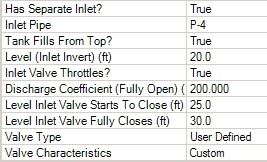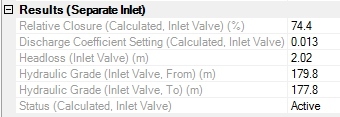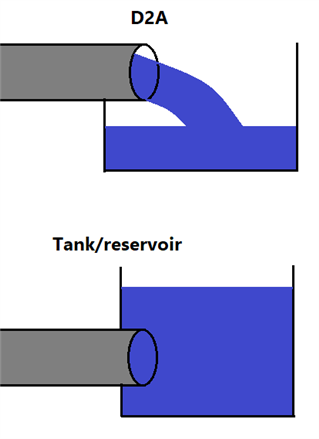| Applies To |
|
| Product(s): |
WaterGEMS, WaterCAD, HAMMER |
| Version(s): |
CONNECT Edition and V8i 08.11.02.31 and later |
| Area: |
Modeling |
| Original Author: |
Jesse Dringoli, Bentley Technical Support Group |
Background
In the past, modeling a top-filling tank involved using an upstream PSV with HGL setting equal to the inlet invert. It also assumed a closed or open status for the tank and instantly closed it only when the tank became 100% full. A separate valve node with controls would be needed to model a gradually closing float valve.
As of version 08.11.02.31 (V8i SELECTseries 2), WaterCAD and WaterGEMS have the ability to model the top-filling behavior and a throttling inlet valve, both built right into the tank element.
Top filling tank
In general, tank inlet and outlet piping are treated as being connected to the tank at the bottom and have only a single altitude valve that shuts the tank off from the rest of the system when the tank reaches its maximum level or elevation. However, some tanks are filled from the top or have altitude valves (sometimes called a "Float Valve") that gradually throttle before they shut. This can be controlled by setting the Has Separate Inlet? Property to True. The user must pick which of the pipes connected to the tank is the inlet pipe, which is controlled or top fill. If there is a valve vault at the tank with an altitude valve on the fill line and a check valve on the outlet, these should be treated as two pipes from the tank even if there is a single pipe from the tank to the vault.
If your tank is a top filled tank (which may refer to a side inflow tank above the bottom but below the top) you can model this directly in the properties of the tank node. Select "True" for the "Tank Fills From Top?" property and set the invert level (relative to the base elevation) of the inflow pipe at its highest point. Water will not flow into the tank through that pipe unless the hydraulic grade is above that elevation.
Note: The invert for the inlet pipe is a "level," not an "elevation." This means that invert level should be the level relative to the base elevation of the tank. If an elevation value is entered instead of a level, this will impact the results for your system.

Float valve / throttling inlet valve
If the inlet valve throttles the flow as it nears full, the user should set the "Inlet Valve Throttles?" property to True. The user must then enter the discharge coefficient for the valve when it is fully open, the level at which the valve begins to close, and the level at which it is fully closed. These levels must be below the top level and any pumps controlled by the valve should not be set to operate at levels above the fully closed level. The closure characteristics are determined by the Valve Type which the user selects from a drop down menu.

Related Results fields
When the tank is described as having a separate inlet, additional results properties are calculated beyond the usual values of tank levels (elevations) and flow. The user can also obtain the relative closure of the inlet valve, the calculated discharge coefficient, the head loss across the valve, and the inlet and outlet hydraulic grade of the valve and finally the inlet valve status.

Example Model
A modified version of the "Example5" model is available from the below link, to illustrate the use of these features. Note that this model is saved in version 08.11.05.61 format.
Top Fill Tank and Separate Inlet Example
Details of the configuration of the tank (T-1):
- Maximum tank level: 31.6 m.
- Invert of inlet pipe: 31.2 m (just below the top)
- level inlet valve starts to close: 30.2 m (1 m below the pipe)
- level inlet valve fully closed: 31.0 m (just below the pipe level)
- discharge coefficient (fully open) : 0.05 m^3/s/mH2O^0.5 (arbitrary)
- Upstream pump: controls disabled, pump always on
When the tank level rises above 30.2 m, the inlet float valve starts to close the inlet pipe, preventing the tank from becoming full. During this time, the pump flow decreases since less water is filling the tank. As demand increases and the tank starts to drain more the inlet valve opens back up and the pump flow increases.

Multiple Inlet Pipes
To model a top-fill tank with multiple inlet pipes, use PSVs instead (this is how the top-fill option is handled internally as well). Set the PSV HGL setting equal to the invert of the pipe that connects to the tank, and use a short, frictionless pipe between the PSVs and the tank. You could set the diameter to something large, with a very smooth friction coefficient and one foot length. See illustration:

Can you have reverse flow through the pipe that serves as the inflow pipe on a top-fill tank?
There is an implied valve that prevents reverse flow into the inlet pipe. Flow into a top-fill tank is assumed to be forward flow only (filling from the top).
Top-Fill Tanks in a Transient Simulation in HAMMER
When modeling a transient simulation in HAMMER, top-fill tanks should be modeling differently. Since there is an air gap between the pressurized pipe, and the tank water surface, a hydraulic transient would not pass between the pipe and the tank, hence the tank itself should not be modeled. Instead, it is best to end the transient model at the discharge point, using either the Discharge To Atmosphere (D2A) or a demand at a junction. Demands are always treated as pressure dependent during the transient simulation, so these are just two different ways of modeling the same thing.
With the demand approach, you simply enter the known outflow demand, then the initial conditions solver will compute the pressure. With the D2A approach, you enter a known pair of flow and corresponding pressure drop (which can be derived for example from the orifice equation).

See Also
Error or bad results when using top filling tank option